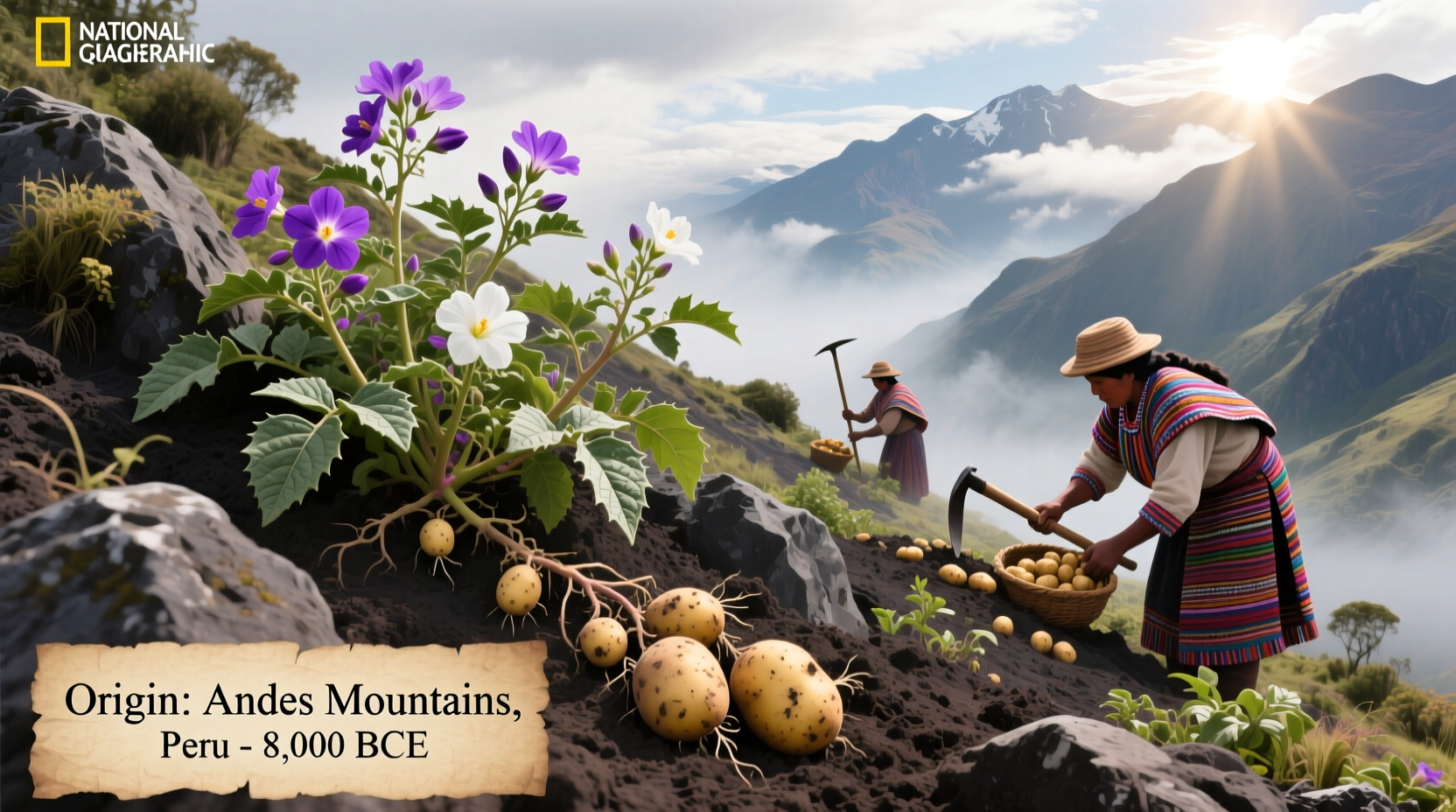The Ancient Roots of a Global Staple
When you bite into a French fry or enjoy a comforting potato salad, you're experiencing a food with one of the most fascinating origin stories in agricultural history. The potato's journey from a high-altitude tuber to a worldwide dietary staple spans continents and centuries, transforming global cuisine in the process.
Tracing Potato Origins: Scientific Evidence
Archaeological evidence confirms that potatoes were first cultivated in the Andean region between 7,000 and 10,000 years ago. Researchers from the International Potato Center (CIP) in Lima, Peru have identified the area around Lake Titicaca—straddling modern-day Peru and Bolivia—as the epicenter of potato domestication. This high-altitude region provided the perfect conditions for wild potato species to thrive and eventually be cultivated by ancient civilizations.
| Time Period | Key Developments | Archaeological Evidence |
|---|---|---|
| 8000-5000 BCE | Initial domestication by indigenous communities | Carbonized potato remains found at archaeological sites in Peru |
| 2500 BCE | Spread throughout Andean region | Potato remains in ancient storage facilities |
| 1530s CE | Spanish introduction to Europe | Ship manifests and colonial records |
| 1700s CE | Global spread as staple crop | Agricultural records across Europe and Asia |
Why the Andes? Understanding the Perfect Conditions
The unique environmental conditions of the Andes mountains created an ideal ecosystem for potato development. At elevations between 3,800 and 4,000 meters above sea level, the region offers:
- Cool temperatures that prevent tuber greening
- Abundant rainfall patterns matching potato growth cycles
- Natural protection from pests due to altitude
- Diverse microclimates allowing for multiple varieties
According to research published by the National Academy of Sciences, the Andean region contains over 4,000 native potato varieties—a genetic diversity that doesn't exist anywhere else on Earth. This incredible variety developed through centuries of selective breeding by indigenous farmers who understood how to adapt potatoes to different microclimates and soil conditions.

From Andean Staple to Global Superfood
The Spanish conquest of South America in the 16th century marked the beginning of the potato's global journey. Spanish conquistadors first encountered potatoes when they arrived in the Inca Empire around 1532. By the late 1500s, potatoes had reached Europe, though their adoption was initially slow due to misconceptions about their safety.
Historical records from the Royal Botanical Garden of Madrid document how Spanish explorers brought potato tubers back to Europe in 1570. The crop gradually gained acceptance across the continent, with Ireland becoming particularly dependent on potatoes by the 18th century—a relationship that would have devastating consequences during the Irish Potato Famine of the 1840s.
Modern Significance of Potato Origins
Today, understanding potato origins isn't just academic—it has practical implications for global food security. The genetic diversity found in native Andean potatoes provides crucial resources for developing disease-resistant and climate-adaptive varieties. As climate change threatens traditional potato-growing regions, scientists are increasingly turning to these ancient varieties for solutions.
The International Potato Center (CIP), established in 1971 and headquartered in Lima, Peru, maintains the world's largest collection of potato diversity with over 7,000 accessions. Their research demonstrates how traditional Andean knowledge combined with modern science can help address contemporary agricultural challenges.
Preserving Ancient Knowledge for Future Generations
Indigenous communities in the Andes continue to practice traditional potato farming methods that have been passed down for millennia. Organizations like Asociación ANDES in Peru work with local farmers to preserve both potato biodiversity and the cultural knowledge associated with these ancient crops.
When you understand where potatoes originated, you gain more than historical knowledge—you connect with a living agricultural tradition that continues to evolve while maintaining its ancient roots. This knowledge helps us appreciate not just the food on our plates, but the centuries of human ingenuity that brought it there.
Frequently Asked Questions
Where did potatoes originally come from before spreading worldwide?
Potatoes originated in the Andes mountains of South America, specifically in what is now modern-day Peru and Bolivia. Archaeological evidence shows they were first domesticated by indigenous communities in this region approximately 8,000 years ago.
Which country is considered the birthplace of the potato?
Peru is widely recognized as the birthplace of the potato, with the area around Lake Titicaca (which borders both Peru and Bolivia) being the specific region where potatoes were first domesticated. The International Potato Center in Lima, Peru maintains the world's largest collection of potato varieties.
How did potatoes spread from their origin country to the rest of the world?
Spanish conquistadors introduced potatoes to Europe in the late 16th century after encountering them in the Inca Empire. From Europe, potatoes gradually spread to other parts of the world through trade routes, becoming a staple crop in many countries by the 18th and 19th centuries.
Why is the origin country of potatoes important for modern agriculture?
The Andean region contains over 4,000 native potato varieties, representing crucial genetic diversity that helps scientists develop disease-resistant and climate-adaptive potato varieties. This genetic resource is increasingly important as agriculture faces challenges from climate change and emerging plant diseases.











 浙公网安备
33010002000092号
浙公网安备
33010002000092号 浙B2-20120091-4
浙B2-20120091-4